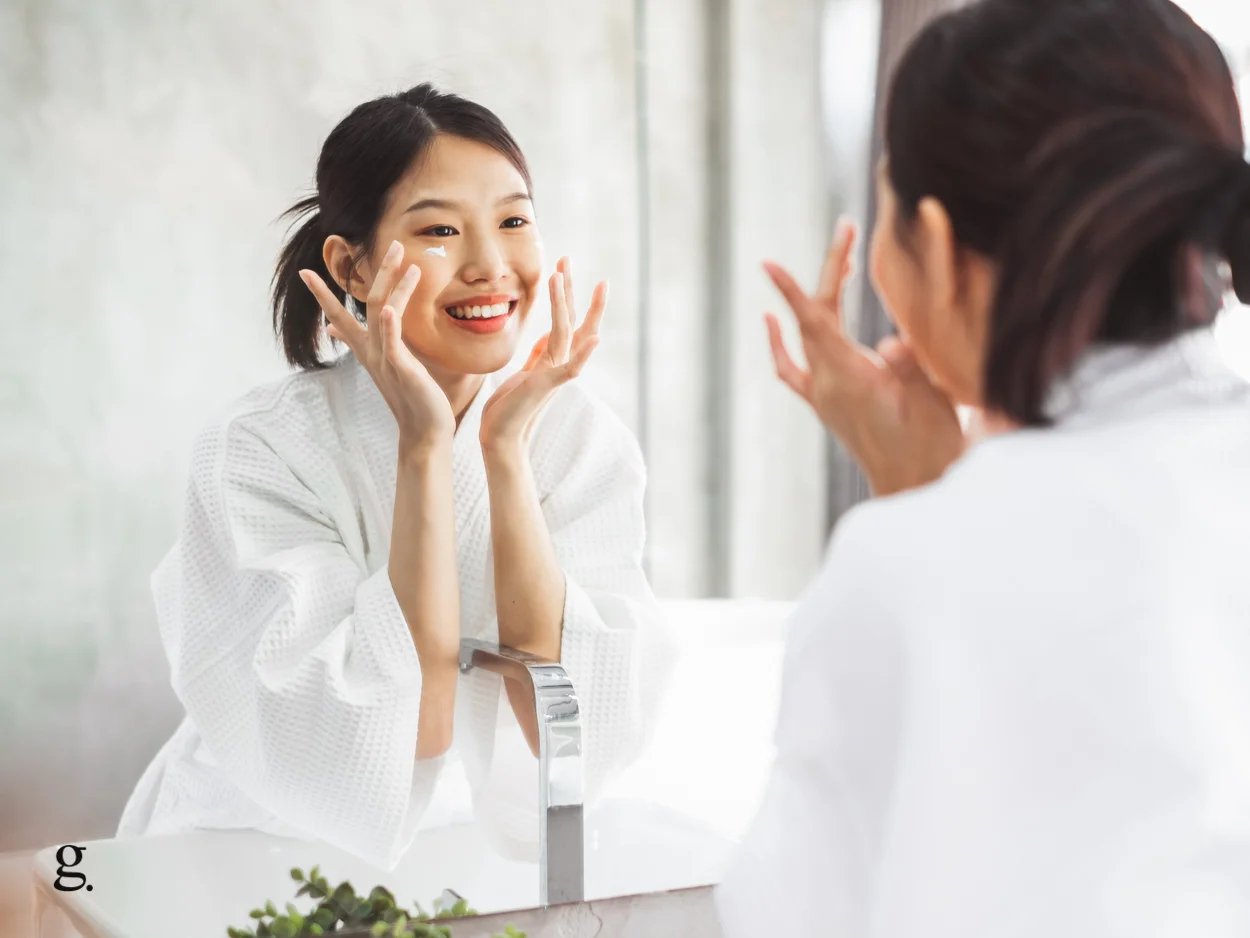When it comes to beauty and looking after one’s skin, nobody does it quite like the Koreans. Korea has a huge skincare industry, commonly called k-beauty, and some of the most innovative products stem from there.
No one person actually “invented” this routine, rather, it’s an evolved methodology that’s settled on its current form.
For a nation so passionate about skincare, it doesn’t come as much of a surprise that they’ve devised their own go-to 10-step skincare routine, that’s significantly more advanced than skincare routines found elsewhere and boasts results such as “glass skin”, which is a phrase coined by the Koreans that means poreless, supple and glowing skin that’s so clear it looks like glass.
How does the Korean skincare routine differ from a normal one?
The standard Korean skincare routine is essentially a regular skincare routine on steroids – it involves doing everything and using every skincare product ever conceived (including double-cleansing, which involves washing your skin twice)!
To make things easy on the eyes, we’ve put together a chart to help you see the key differences below:
Basic routine
Step 1:
Cleanse
Step 2:
Exfoliate
Step 3:
Use treatment(s)
Step 4:
Moisturize
Step 5:
Apply sunscreen
Korean routine
Step 1:
Cleanse
Step 2:
Cleanse again
Step 3:
Exfoliate
Step 4:
Tone
Step 5:
Apply essence
Step 6:
Use treatment(s)
Step 7:
Use mask(s)
Step 8:
Apply an eye cream
Step 9:
Moisturize
Step 10:
Apply sunscreen
The Korean skincare routine steps explained
Step 1: cleanse face (with an oil-based wash)
As with any skincare routine, the first step involves giving your face a deep clean.
In the case of the Korean routine, it specifically dictates that you use an oil-based cleansing product.
The thinking behind this is that oil and water don’t mix, so using an oil to cleanse your face will effectively remove all traces of makeup and dirt, without stripping your skin of its natural oils.
Step 2: cleanse face again (with a water-based wash)
Once you’ve washed your face with an oil-based cleanser, next you’re going to wash it again with a water-based product.
This is known as a “double cleanse”.
While you may be thinking “but isn’t my face already clean after step 1?”-to which the answer is yes-, this 2nd step is essentially there to catch anything you may have missed. Excessive? Sure, but it’s a foolproof method of guaranteeing completely clean skin.
Step 3: exfoliation
The third step in the Korean skincare routine is to exfoliate with a product of your choosing.
Exfoliating the skin is a process of removing dead skin cells from the surface of the skin. This can be done by mechanical means, such as using a loofah, washcloth, or bespoke scrubbing device like a skin spatula, with chemical exfoliants, such as gels containing AHA/BHA, or with physical exfoliants that contain abrasive particles within their formula that actively “scrub” the skin clear.
Exfoliating has multiple benefits for the skin, including unclogging pores, brightening the complexion, and reducing the appearance of fine lines and wrinkles.
It is important to choose an exfoliator that is appropriate for your skin type, as some exfoliants can be too harsh and cause irritation. When used correctly, exfoliating can leave your skin looking and feeling smooth and radiant.
Step 4: toner
As the Korean skincare routine involves a ton of washing and exfoliating, your skin’s natural pH level is very likely to be unbalanced afterward, which is why toners are an integral part of the routine.
Skin pH is a measure of the acidic or alkaline nature of the skin. The pH scale ranges from 0 to 14, with 7 being neutral. A pH of less than 7 is considered acidic, while a pH of greater than 7 is alkaline. The optimal pH for the skin is between 4.5 and 5.5. This slightly acidic environment helps to maintain the skin’s natural barrier, which protects against bacteria and other environmental threats.
When the skin’s pH becomes too alkaline or too acidic (which can happen after intense bouts of washing/cleansing), it can become irritated and feel dry. While your skin will eventually rebalance itself, it can take time, therefore, it is important to use products, such as toners, that are formulated to help bring your skin’s pH levels back into a normal range.
Step 5: Essence
This may be the first step that introduces a skincare product category that many people won’t have even heard of: essences.
Essences, also sometimes called mists, are relatively new to the skincare market and mostly unique to Korea (though you may be able to find these products on western shelves).
They function as an extremely lightweight sprayable serum designed to hydrate the skin.
Step 6: treatments
This is the step where you tailor the routine to fit your actual requirements – by using any bespoke skincare treatment serums you want.
Step 6 is where you could use things like dark spot serums, antioxidant serums, anti-aging serums, pore minimizers, dark circle creams, etc. The world is your oyster when it comes to treatments, so ask yourself what your skin goals are and look for some products that are tailored for that specific purpose.
Step 7: Sheet Mask
This step is probably the most “extra” of them all, but sheet masks are a fun and easy way to give your skin a quick boost of hydration or other nutrients.
Sheet masks are essentially thin sheets of fabric (usually cotton) that have been soaked in a variety of skin-moisturizing ingredients. The most common sheet mask ingredients are hyaluronic acid, vitamin C, green tea, and aloe vera.
Step 8: eye cream
Eye creams are moisturizing/anti-aging/brightening formulations. As the skin around our eyes is so sensitive and delicate, it is important to use a product that is specifically designed for that area, which they are.
While you could technically use a regular moisturizer or serum around your eyes, eye creams usually have a lighter formulation that is less likely to irritate. In addition, many eye creams contain ingredients that are specifically beneficial for the eye area, such as caffeine, which can help to reduce the appearance of dark circles.
Step 9: moisturize
After all the cleaning, pH-rebalancing, treating, mask-wearing, and eye-cream-applying comes one of the most important stages of all – moisturizing.
When skin is healthy, it looks hydrated and plump. However, when it is dehydrated, it can become dry, flaky, and more prone to the visible signs of aging. Moisturizing helps to prevent this by locking in moisture and keeping the skin quenched, soft, and supple.
The most popular types of daily moisturizers are called day creams, which are lightweight, non-greasy formulas that absorb fast and don’t linger on the skin, allowing you to apply makeup without it caking or clumping due to skincare-product buildup on your face.
Step 10: sun-protect
Finally, we get to the final step, which is applying sunscreen (SPF).
Sunscreen is important because it helps to protect your skin from the harmful effects of UV rays, which can cause things like sunburn, premature aging, and other unpleasant things.
When choosing a sunscreen, it is important to make sure that it has an SPF of at least 30 and is labeled “broad-spectrum”, which means that it will protect you from both UVA and UVB rays.
Furthermore, there are two types of sunscreens available: chemical and physical (aka. mineral).
Mineral sunscreens rely on zinc oxide and titanium dioxide to block UV rays, while chemical sunscreens use a variety of different compounds to absorb UV radiation.
There are several key differences between these two types of sunscreen. Mineral sunscreens generally provide better protection from UV rays, but they can be more difficult to apply evenly and can leave a white residue on the skin. In addition, mineral sunscreens are typically less expensive than chemical sunscreens.
Chemical sunscreens, on the other hand, are usually clear when applied and absorb faster, but they may be more likely to irritate sensitive skin.
When choosing a sunscreen, it is important to identify your own needs and preferences to select the best product for you.
Is the Korean skincare routine better than a routine?
This is probably the most comprehensive skincare routine you could follow; the aim of it is to maximize every single aspect to provide the most benefits as humanly possible, so technically yes it is indeed better than a regular one.
Despite being extremely thorough, a routine like this is fairly pedantic, and is undoubtedly excessive for the majority of people – it’s only the diehard skincare fanatics who’ll want to give this one a try.
The complete list of benefits includes:
- Skin feeling softer and smoother
- Brighter & more radiant skin
- Increased skin hydration
- Improved skin barrier
- Balanced skin pH levels
- Exfoliated skin
- Reduced signs of aging
- Protection against sun damage
While that may sound fantastic, there’s a but – a regular skincare routine will give you these benefits too, just not to the same extent.
To be honest with you, the benefits the Korean skincare routine will provide you with aren’t going to be much different than a regular skincare routine – all the extra steps added are designed just further enhance what you’d already get.
Conclusion
Think of the 80/20 rule; 80% of the benefits from your skincare routine will come from 20% of your efforts. Going the extra mile and spending all that extra time and money to squeeze out a little more benefit from your skincare routine may or may not be worth it, so ask yourself critically if it’s worth it before diving in.
Despite our valid criticisms, the proof is in the pudding when it comes to Korean skincare – they undoubtedly have it down to a highly refined science, and their products are some of the most popular on the market.
So, if you’re up for the challenge and have the time and patience to commit to such an extensive skincare routine, then go for it!

